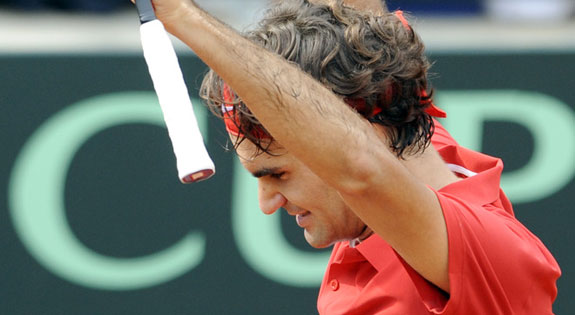It was on September 22, 1997 that 16-year-old Roger Federer debuted on the ATP computer. As documented in the book ON THIS DAY IN TENNIS HISTORY, Federer was less than two months after turning 16 years old when he debuted on the ATP computer with a world ranking of No. 803. Nearly six and half years later, the man from Basel, Switzerland moved into the No. 1 ranking on the computer, and kept the top spot for more consecutive weeks than any player in the history of the sport.

Rene Stauffer, the Swiss reporter who wrote the Federer biography THE ROGER FEDERER STORY: QUEST FOR PERFECTION ($24.95, New Chapter Press, www.RogerFedererBook.com), documents the future six-time Wimbledon champion during this time period in his global selling book, excerpted below.
His rush towards the top continued unimpeded in 1997 when he won both the indoor and outdoor Swiss national junior championships in the 18-and-under division. These titles marked his last national titles as Roger became more focused on the challenges of international tennis. Allegro, who fell victim to Federer during his final national junior triumphs, said he began to notice the enormous potential that lay dormant within the player. “When Roger was returning to Ecublens from a major international junior tournament in Prato, Italy, I asked him how it went and how did he play,” Allegro said. “Roger said, ‘Well. Thank you. I won.’ I said, right, sure, but he had really won and, not only that, but without losing a set. I thought to myself if he can win at tournament like this at 16, he’s really going to be a great player.”
Allegro recalled another story during this time period that also impressed him and gave him the indication of where Federer was headed. “We had to fill out a form stating our goals. Everybody wrote: To someday be among the top 100 in the world, but Roger was the only one to write: To first be in the top 10 in the world and then become No. 1,” he said. “From that point on, we viewed him in a different light.”
Swiss Tennis made a big move in 1997. Ecublens served its purpose and the “House of Tennis”—the new Swiss National Tennis Center opened in Biel along the German-French language border within Switzerland. The National Tennis Center, the “Tennis Etudes” program as well as the association administration was united under one roof at this facility. There were courts with a variety of surfaces, a modern restaurant and a real players’ lounge—a vast improvement over Ecublens.
At the same time, Swiss Tennis also expanded its training staff. Among the new members of the coaching staff was Peter Carter, Federer’s coach from Basel. “He was brought in under the ulterior motive that he could be paired with Roger,” Annemarie Rüegg admitted. “We saw the potential he had and wanted to provide him with individualized training.” Federer also sometimes worked with another coach, Peter Lundgren, a former professional player from Sweden.
In the summer of 1997, at the age of 16, Roger Federer completed the mandatory nine years at school and decided to become a professional tennis player. With the exception of a few English and French lessons, he concentrated completely on the sport from this point forward. His parents were aware that this step was unpredictable and risky. “We had immense respect for the entire process,” Robert Federer recalled. “Everybody was telling us how talented Roger was,” his mother added. “But we wanted to see results. We made it very clear to Roger that we could not financially support him for ten years so that he could dangle around 400 in the world rankings.” Although the parents’ financial commitment to Roger’s career was sustainable—due to the Swiss Tennis Federation’s assistance with Roger—Lynette Federer increased her workload from 50 to 80 percent in order to ensure the family’s financial security. Money, it would soon prove, would not become an issue for very long.
Now training in Biel, Roger no longer lived with a guest family and moved into an apartment with his good friend Allegro. “Roger’s parents approached me and said that he would like to share an apartment with an older player and they asked me if I would be willing to do this,” said Allegro. “This sounded financially interesting to me so Roger’s and my parents went out looking for apartments together.”
The 16-year-old and the 19-year-old teenagers moved into a two-bedroom apartment with a kitchen, a bathroom and a small terrace above a soccer field. “We often watched matches and gave live commentary,” Allegro said. “It was a lot of fun. I usually did the cooking because I had more experience. Roger didn’t have much initiative but he always helped if I asked him to. His room was usually somewhat messy and when he cleaned it up, it was just as chaotic two days later.”
The young professionals, however, were completely focused on the sport. They otherwise passed the time watching television or playing electronic video games. “Roger was never a party guy,” Allegro said. “I once read that he drank alcohol but that only happened very rarely.” He played computer games sometimes until two in the morning but he never went out or went to parties.
Marco Chiudinelli, meanwhile, moved to Biel to further his tennis abilities and also became part of Federer’s circle. “We were cyber world guys,” said Chiudinelli. “We never felt attracted to parties and smoking or drinking didn’t interest us. We preferred to hang out on the courts or at the Playstation.”
Roger was still the same playful, fancy-free hot head whose temper sometimes exploded. “You often heard a yodeling, a liberating primal scream from the dressing room or the players’ lounge,” Annemarie Rüegg recalled. “You knew it was Roger. He needed to do this as a release. He was pretty loud but it wasn’t unpleasant.”
